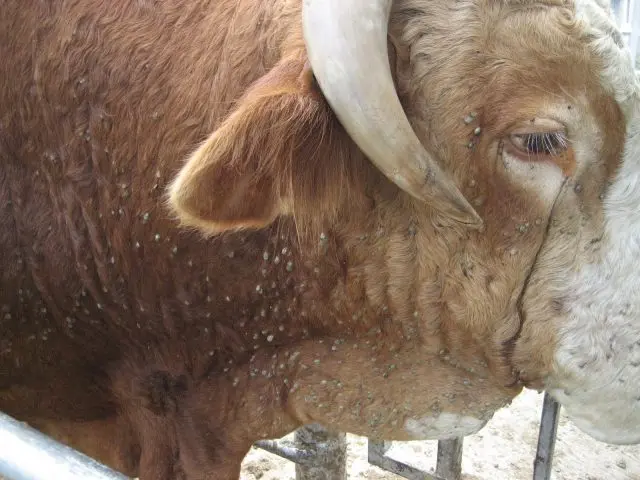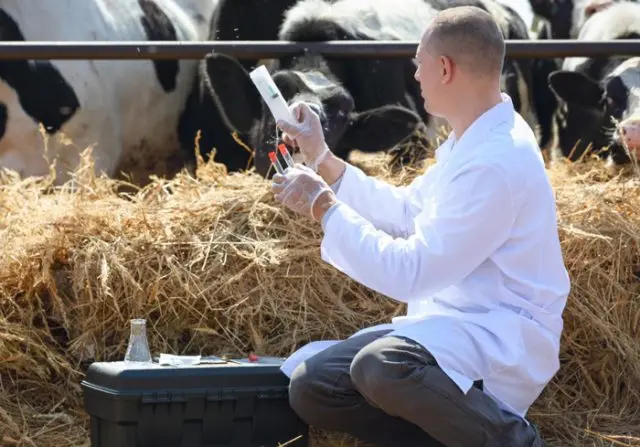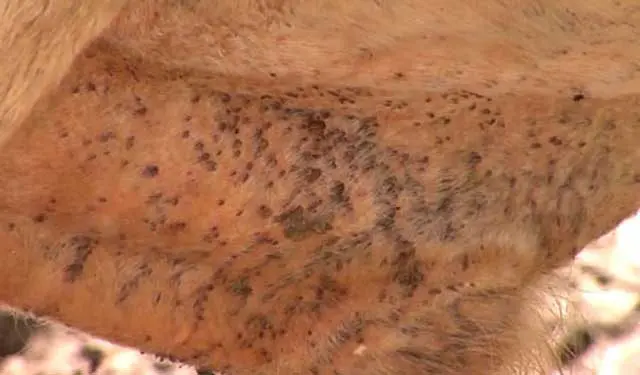Contents
Lice in calves and adult cows is not uncommon on farms. The greatest number of infections is observed in the winter months, when the density of the coat increases in animals, however, the parasite is active throughout the year.
Lice cause great damage to the farm, as the stress of pain in cows reduces milk yield, but young calves are especially affected. Unlike mature animals, they have weaker immunity and relatively thin skin, which is easier for lice to bite through. Since insects are carriers of many infections, calves often become seriously ill after an infestation of lice.
Types of lice parasitizing on cattle
Lice are small wingless insects, highly specialized parasites that live on only one or some related animal species. Infection with these insects is called pediculosis.
Most often, cows are affected by the following subspecies of lice:
- Short-headed cow louse – an insect of rather large size, the length of an adult reaches 4 mm. The abdomen of the parasite is dark with a blue tint, the head and chest are painted in yellowish-gray tones. The nits are white, the eggs are covered with a thick dense shell. The life cycle of a louse is 14-15 days, during which time the louse lays 10 to 18 eggs. After another 1-2 weeks, new individuals hatch from the eggs and the cycle soon repeats. Insects concentrate mainly on the neck of animals, it is there that a large accumulation of white nits can be found.
- Long-headed calf louse. The size of this louse does not exceed 2 mm in length, however, its life expectancy is quite long – about 4 weeks. Parasites hatch from the eggs in the 2nd week after the clutch has been made. After another 2 weeks, the insects reach maturity and also begin to lay eggs. It is very difficult to detect the long-headed calf louse in the hair of a sick animal due to its small size.
- Hairy louse. This is the smallest parasite that infects cattle – its length is only 1-1,5 cm. The life expectancy of a hairy louse reaches 3-4 weeks. Parasites are concentrated on the head of a cow. A distinctive feature of this louse is its low mobility – it practically does not move through the body of the animal after it sticks to a certain area of uXNUMXbuXNUMXbthe skin. During the day, the parasite lays one egg, sometimes two. The louse is detected by the characteristically curved hairs of the coat, to which the females of the parasite attach their eggs.
The source of the spread of lice in most cases are already infected cows. Parasites pass to the coat of healthy individuals through touch in crowded conditions and during sexual contact during mating. Also, infection can occur through dirty bedding or care items on which lice nits remain.
Signs of lice in cattle
The first sign of the presence of lice in cows and calves is a scattering of white or dark dots on the animal’s coat. Female lice lay their eggs on hairs, with the highest concentration of nits occurring in:
- head (especially the area near the horns);
- neck
- tail.
In small calves, the location of lice on the body is somewhat different; in them, parasites are concentrated mainly at the bottom of the neck and on the limbs from the inside. Lice eggs sit firmly on the fur of cattle – animals cannot shake them off.

When lice appear in cows and calves, the following changes in behavior and appearance are noted:
- the animal becomes aggressive, irritable for no apparent reason;
- the cow behaves restlessly, every now and then jumps to its feet when it lies, or, conversely, becomes lethargic and lethargic;
- numerous small hemorrhages and nodules, eczema appear on the skin of a sick individual;
- strong scratches, abrasions and scratches become noticeable on the skin – in an attempt to relieve severe itching from cow bites, they rub their bodies against various objects;
- a large trembling passes through the body of the animal at times;
- due to stress from pain during insect bites, cows refuse food and quickly lose weight, give less milk;
- calves noticeably weaken, they have anemia.
In addition, with a high concentration of lice on the body, cows are much more likely to get sick, since sick animals have reduced resistance to infections.
Treatment of pediculosis
The first thing to do after finding lice in a cow is to transfer the animal to a separate clean room and call a veterinarian. He must determine the subtype of the parasite, in accordance with this, treatment will be prescribed.
Regardless of which method is used to combat the parasite, breeding is carried out in several stages, taking into account the length of the life cycle of lice. It is important to destroy not only adults, but also newly hatched nymphs, otherwise they will lay eggs and all work will be in vain. Since the parasites hatch at different times, the cows are treated in waves. On average, 2-4 treatments with chemicals or folk remedies are required to completely get rid of lice. For the purpose of prevention, additional spraying is carried out to exclude the survival of individual individuals.
Veterinary drugs
Medicines for fighting lice are conditionally divided into preparations for internal and external use. The following drugs are considered the most effective:
- “Neostomozan” – concentrated emulsion, which must be diluted with water before use. The agent is applied to the skin of a cow by spraying or rubbing it with a sponge. After 2 hours, the drug is washed off. Procedures are carried out once a week.
- “Chlorophos” – A 0,5% solution is used to spray the skins of sick cows once a week.
- “Ivermek” – the drug is injected into the neck or croup, the effect lasts 1-2 weeks. The optimal dose for an adult animal is 20 mcg per 1 kg of cow weight. The medicine should not be used to remove lice on milking and pregnant individuals.
- “Sebacil” – the product is rubbed into the skin of the cow and left for 5-6 minutes. Then the agent must be washed off. During lactation cows “Sebacil” can not be used.
- “Neostomazan” – before use, the drug is diluted in water, in a ratio of 1:400. Approximately 1 liter of solution is consumed per animal.

All anti-lice drugs are used according to the instructions, unless otherwise recommended by a doctor. Some time after treatment, milk from a sick cow should not be eaten. Calves should also not be given it, so as not to cause intoxication in them. Accumulated in the body of harmful substances are excreted on average after 5-7 days.
Folk remedies
You can remove lice using folk methods that have been proven over the years. In terms of speed, they are sometimes inferior to industrial chemicals, however, they have one big advantage – all the substances that cows are treated with are products of natural origin. They do not have any negative effect on the meat and milk of processed animals, while some particularly strong chemicals can accumulate in the body of a cow.
The most effective folk remedies for treating lice include the following substances:
- Wood ash. Within two weeks, the ashes are rubbed into the cow’s skin, paying special attention to the places with the highest concentration of insects. The procedure is carried out without strong pressure, since wood ash can cause irritation with intense exposure to the skin.
- Vegetable oil. The substance creates a thin film on the body of sick cows that blocks access to oxygen for lice. In addition, the oily coating makes it difficult to move through the body of the animal, causing the parasites to fall to the ground. For greater efficiency, a small amount of kerosene is added to the oil.
- Vinegar. The main advantage of this method is that after treatment with vinegar, not only the lice themselves die, but also their nits, however, the liquid cannot be used in its pure form. A high concentration of acid can cause numerous burns on the skin, especially if the lice are removed from the calf, since their skin is very delicate. 9% vinegar must be diluted with water in a ratio of 1: 2, after which the solution is applied to accumulations of parasites.
- Birch tar. The substance is rubbed into the skin of a cow for about a week in the area of the neck, head and tail.
- Decoction of wormwood. For preparation, the plant is infused for about half an hour in 1 liter of boiling water, in which 3 pieces of grated tar soap are diluted and the resulting solution is diluted with hellebore water (you can buy it at a pharmacy). With this decoction, the cow’s hair is washed for a week, after which they stand a break for another week. Total treatment takes 4 weeks (2 weeks of rubbing and 2 pauses).

Room processing
Unfortunately, for the final solution of the problem, it is not enough to remove parasites from a sick animal. When a cow returns to the stall, it can become re-infected: lice nits remain in bedding, feed, on cattle care items, etc. To prevent this from happening, all utility rooms are disinfected with chemicals.
The most effective include the following insecticides:
- “Hexamide”;
- “Dicrezil”;
- “Chlorophos” (0,5%).
You can also use a special checker “Pawn-V” to clean rooms from lice. The active substance contained in it causes paralysis in parasites, soon after that the lice die. For animals and humans, the checker is harmless, its components decompose after 3-4 hours after application.
Seasonal processing of the place of keeping cows is carried out, as a rule, in the summer months or before the stall period.
Preventive measures
It is possible to prevent the appearance of lice in calves and adult cows with strict adherence to the following preventive measures:
- in the room where the cows are kept, it is necessary to maintain cleanliness and order – to change the litter in a timely manner, in which parasites can hide, remove manure, renew water in drinking bowls, etc .;
- feed for cows should be fresh and varied; feeding with musty hay or spoiled products is unacceptable;
- it is desirable to periodically dilute the diet of cattle with various vitamin supplements to maintain immunity;
- animal skins are cleaned and washed from time to time;
- the place where the herd is kept and the cows themselves are treated with a solution of chlorophos (0,5%).
Conclusion
Lice in calves can appear even in the most well-groomed farm – for example, healthy individuals can pick up parasites from animals that have recently arrived on the farm. On the other hand, removing lice is not so difficult, although this process can stretch for 2-3 weeks. The most important thing in treatment is the systematic treatment. Unlike the insects themselves, lice nits are much more resistant to environmental influences. The parasites in the eggs survive the treatment safely and lay new offspring. In order to prevent this from happening, the cows are treated at a certain interval, destroying the newly hatched insects in waves.
You can learn more about the treatment of lice in cattle from the video below:









